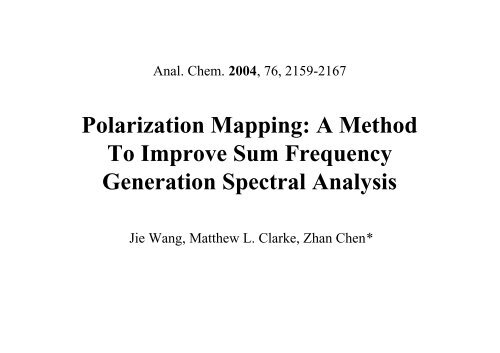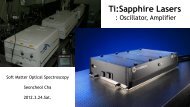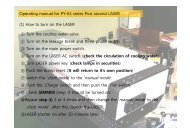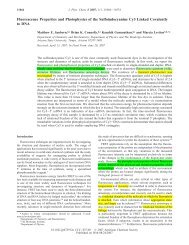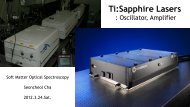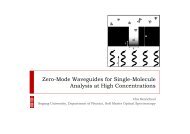E:\组会\20110319\Polarization Mapping参考文献\Polarization Mapping
E:\组会\20110319\Polarization Mapping参考文献\Polarization Mapping
E:\组会\20110319\Polarization Mapping参考文献\Polarization Mapping
Create successful ePaper yourself
Turn your PDF publications into a flip-book with our unique Google optimized e-Paper software.
Anal. Chem. 2004, 76, 2159-2167<br />
Polarization <strong>Mapping</strong>: A Method<br />
To Improve Sum Frequency<br />
Generation Spectral Analysis<br />
Jie Wang, Matthew L. Clarke, Zhan Chen*
Polarization <strong>Mapping</strong><br />
An efficient methods to improve the spectral fitting and resolution of<br />
SFG measurements by collecting SFG spectra using various<br />
polarization angles of the input and output signal beams.<br />
Advantages<br />
Vibrational peaks which are heavily overlapped with each other can<br />
be separated by using polarization mapping method<br />
Polarization mapping method can ensure correct and reasonable<br />
spectra fitting.
SFG:<br />
a) Incidence angles<br />
IR beam: 45º Visible beam: 60º<br />
b) Polarization<br />
IR beam: p polarization direction<br />
Experiments<br />
Visible beam: 45º from the s polarization direction<br />
SFG: collected at various polarization angles of a polarizer in front of the detector.<br />
Sample:<br />
a) Deuterated polystyrene (d-PS)<br />
b) Bovine serum albumin (BSA)<br />
PS
1. SFG Spectral Fitting Background<br />
ei — unit polarization vector of the optical field at ωi<br />
L(ωi) — tensorial Fresnel factor<br />
Incoming beam is in the x-z plane<br />
SFG signal is collected at the reflection direction
σi — the angle between the polarization direction of the beam i and the s<br />
polarization direction.
Visible beam — 45º from the s polarization direction (σ1 = 45º)<br />
IR beam — p polarization direction (σ2 = 90º)<br />
SFG — σs
When the input and output angles of the incident laser<br />
beams are set at the critical angles for internal total<br />
reflection:<br />
L XXZ, L XZX, L ZXX ≈ 0
135º<br />
153º<br />
2. Theoretical Examples<br />
0º<br />
26.6º<br />
45º<br />
PPP<br />
SSP
Vibrational Peaks with Similar Peak Centers<br />
SSP<br />
PPP
Vibrational Peaks with Identical Peak Centers<br />
SSP<br />
PPP
3. Applications to Real Examples<br />
PS<br />
d-PS Surface in Air<br />
sample setup
3. Applications to Real Examples<br />
d-PS Surface in Air
PS<br />
PS Surface in Air<br />
Five C-H vibrational peaks of phenyl group<br />
PPP<br />
SSP<br />
3036 cm -1<br />
3024 cm -1<br />
3069 cm -1<br />
3057 cm -1<br />
3084 cm -1
BSA on the Fused-Silica Surface in Air<br />
PPP<br />
SSP
BSA on the Fused-Silica Surface in Air<br />
PPP<br />
SSP
Conclusion<br />
• Vibrational peaks which are heavily overlapped with<br />
each other can be separated by using polarization<br />
mapping method<br />
• Fitting parameters derived from only fitting the ssp<br />
and ppp spectra may not always be reliable<br />
• Polarization mapping method can improve the<br />
reliability of fitting results


